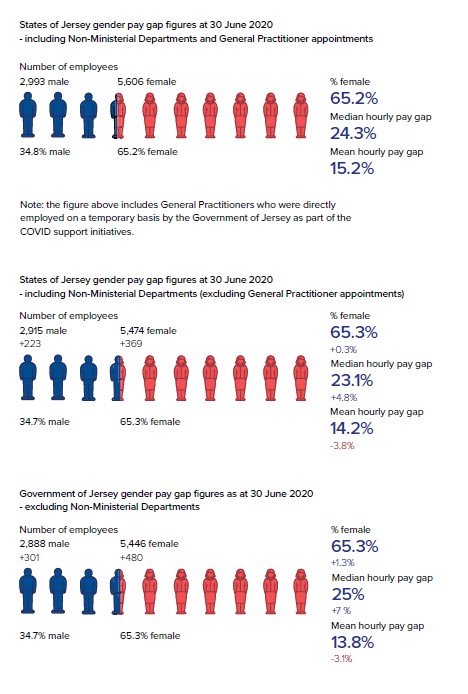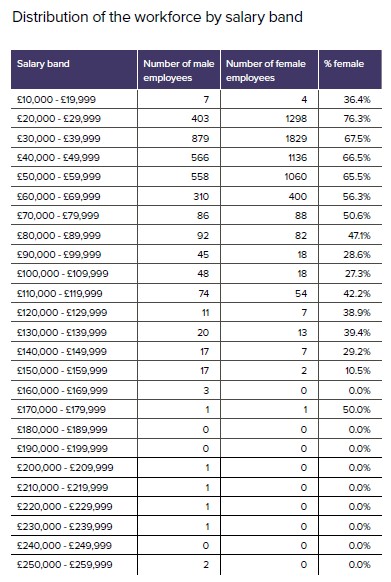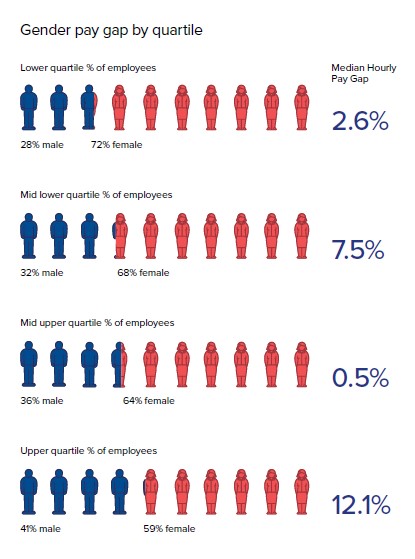


Women continue to make up the majority of the Government’s workforce, but are earning less on average than their male counterparts.
According to the Government's new Gender Pay Gap report, the median gender pay gap - which shows the difference between the average earnings of men and women, but does not measure the difference in pay between men and women doing the same job – was 23.1% in 2020. This was an increase from 2019 when it was at 18.3%.
Meanwhile, the mean pay gap was 14.2% in 2020, slightly less than its 2019 figure of 18.0%.

Pictured: There are twice as many women within States of Jersey departments, as men, but on average, they earn less.
This is despite women being twice as numerous as men across all Government of Jersey departments.
When including non-Ministerial departments – but not GPs, who were temporarily employed by the Government last year during the pandemic - there were 5,474 female employees and 2,915 male ones last year.
The largest proportion of female employees can be found in the Children, Young People, Education and Skills Department (1,999), and Health Department (2,249), where they represent 76% of all employees.
Men represent more than half the workforce in the Infrastructure, Housing and Environment (IHE), and Justice and Home Affairs departments.

Pictured: There are over twice as many women earning under £60,000 a year (5,327) as there men (2,413).
According to the report, women and men “still predominately study for certain careers or apply for or occupy certain roles and professions”, which is reflected in the gender distribution within certain professions: 69% of teachers as well 83% of nurses and midwives are female, while 61% of manual workers, 77% of prison employees and 98% of fire service employees are men.
The figures show there are more than twice as many women earning under £60,000 a year (5,327) as there are men (4,826).
Within the first quartile – which represents the percentage of the workforce on the lowest 25% hourly rate – the median hourly pay gap is 2.6%, going up to 7.5% in the second quartile and 12.1% in the fourth quartile – which represents the percentage workforce on the highest 25% hourly rate. This is despite women making up the majority in each group.
“The distribution of our workforce drives our mean and median figures and, while our workforce is diverse, we continue to have more female workers in lower pay grades,” the report notes.
The report goes on to say that while there are more men than women in tier 1 and tier 2 roles, they earn higher gross hourly earnings, with a negative median hourly pay gap of -17.4% toward men in tier 2 and of 4.0% in tier 2.
“In our most senior roles that attract higher salaries, although there are more men than women employed in this group, on average female gross hourly earnings are higher than those of men therefore the mean pay gap is negative towards male employees at this level,” the report states.
Yet, according to the figures, there is only one woman earning a salary of £170,000 and above, against seven men.
Tier 1 and 2 are also the only categories were “supplements” were included in the calculation, although it is unclear what those supplements are.
Express has contacted the Government for clarification and is awaiting a reply.

Pictured: Across all four quartiles, women earn less than men.
“The States Employment Board (SEB) is working hard to address the issues surrounding the gender pay gap and we will be using this analysis to enhance gender equality in our workforce,” SEB Vice Chair and Assistant Chief Minister, Constable Richard Buchanan, said.
“Closing the gender pay gap will take a significant period of time however we will continue our work to remove barriers to improving the gender balance and diversity in our workforce.
“It is important to recognise imbalances in pay and opportunities across all industries and Government is no different. We are committed to providing equal and fair rewards for all our employees regardless of gender, ethnicity, or any other personal characteristics and we hope that our transparency will encourage other employers in the island to publish their own findings.”
Comments
Comments on this story express the views of the commentator only, not Bailiwick Publishing. We are unable to guarantee the accuracy of any of those comments.